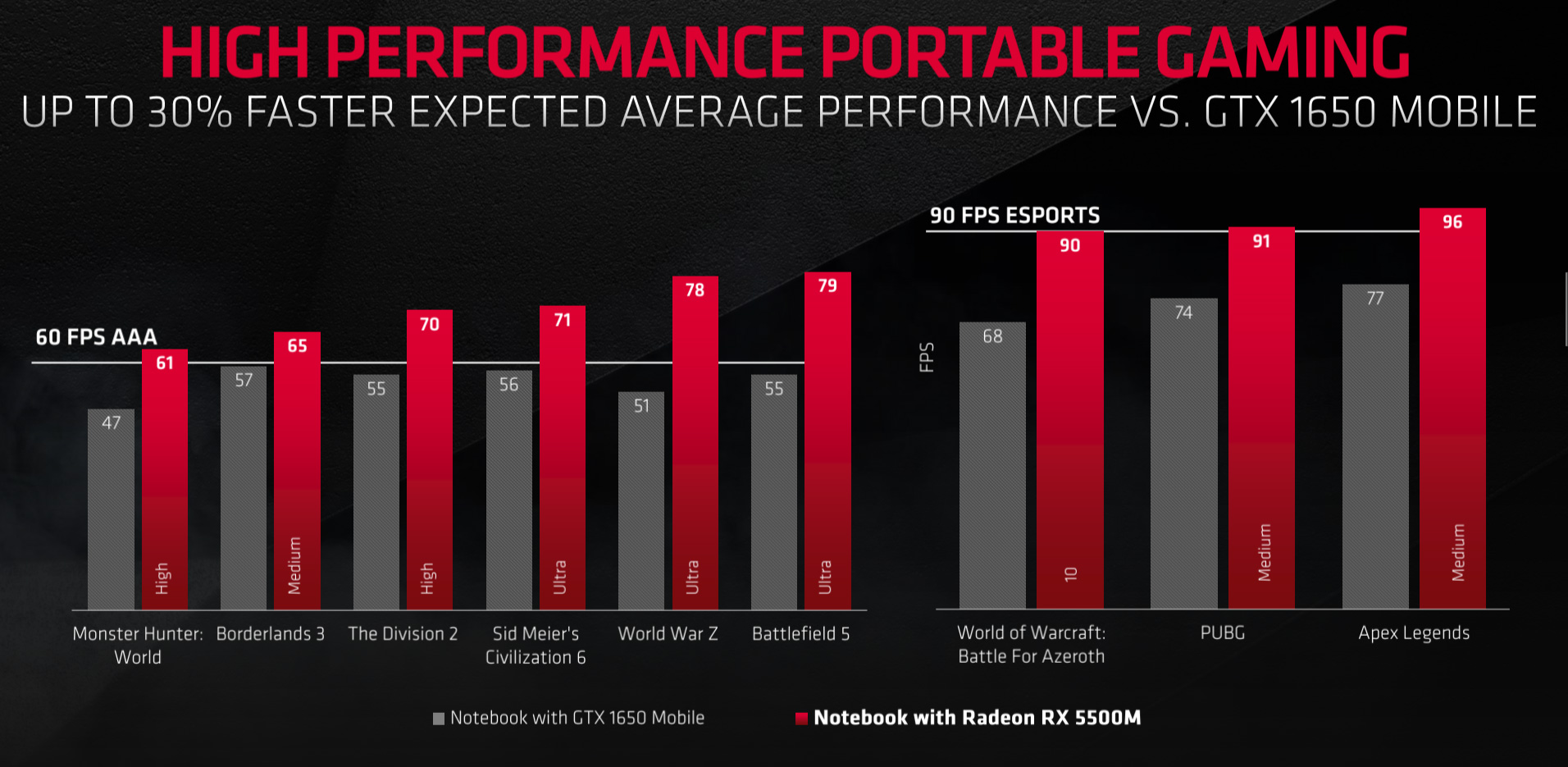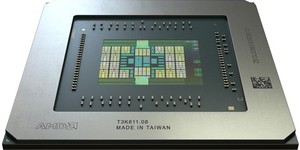
AMD has today announced the Radeon RX 5500 Series of graphics cards, which are based on the 7nm Navi architecture and will launch later this quarter in both laptop and desktop configurations, all targetting 1080p gameplay.
The new Radeon RX 5500 Series products will all be based around a newly built Navi GPU that is significantly less powerful than the Navi 10 GPU which powers the Radeon RX 5700 XT and Radeon RX 5700, which were the first graphics cards to launch with the new RDNA architecture and 7nm process. Desktop users can expect to see the Radeon RX 5500 in both 8GB and 4GB flavours, and AMD will also bring Navi to laptops for the first time with the Radeon RX 5500M, this time solely with 4GB of memory. This is how they compare to the higher-end parts:
| FIELD1 | AMD Radeon RX 5700 XT | AMD Radeon RX 5700 | AMD Radeon RX 5500 | AMD Radeon RX 5500M |
|---|---|---|---|---|
| Architecture | RDNA | RDNA | RDNA | RDNA |
| Codename | Navi 10 | Navi 10 | TBC | TBC |
| Base GPU Clock | Up to 1,605MHz | Up to 1,465MHz | N/A | N/A |
| Game GPU Clock | Up to 1,755MHz | Up to 1,625MHz | Up to 1,717MHz | Up to 1,448MHz |
| Boost GPU Clock | Up to 1,905MHz | Up to 1,725MHz | Up to 1,845MHz | Up to 1,645MHz |
| Compute Units | 40 | 36 | 22 | 22 |
| Stream Processors | 2,560 | 2,304 | 1,408 | 1,408 |
| Texture Units | 160 | 144 | 88 | 88 |
| ROPs | 64 | 64 | 32 | 32 |
| Transistors | 10.3 billion | 10.3 billion | 6.4 billion | 6.4 billion |
| Die Size | 251mm2 | 251mm2 | 158mm2 | 158mm2 |
| Process Node | 7nm | 7nm | 7nm | 7nm |
| Memory | 8GB GDDR6 | 8GB GDDR6 | 4GB or 8GB GDDR6 | 4GB GDDR6 |
| Memory Data Rate | 14Gbps | 14Gbps | 14Gbps | 14Gbps |
| Memory Interface | 256-bit | 256-bit | 128-bit | 128-bit |
| Memory Bandwidth | 448GB/s | 448GB/s | 224GB/s | 224GB/s |
| Board Power | 225W | 185W | 150W | 85W TGP, configurable |
AMD has not named the new GPU, nor has it confirmed whether 22 Compute Units represents the fully-enabled version of it. Its marketing materials do appear to show a 24 CU design, and there’s clearly room in the nomenclature for the ‘RX 5600 Series’, but we’ll leave the speculation there.
What we do know is that this is a very different GPU to Navi 10, with the core counts, back-end, and memory bus all being snipped. 22 Compute Units gives us a total of 1,408 Stream Processors and 88 Texture Units, and AMD has also moved to a 128-bit memory bus and a ROP count of 32 – both of these specs indicate that 1080p really is the focus for this card, as does the availability of 4GB SKUs. All of these changes see the transistor count reduced by about 38 percent compared to Navi 10, resulting in a die size of 158mm2. All RX 5500 Series GPUs support PCIe 4.0, which is of course backwards-compatible with PCIe 3.0.
In terms of clock speeds, AMD has now stopped listing the Base GPU Clock – a sensible move in our eyes, since it only ever referred to the expected clock speed in unrealistic power virus applications like FurMark rather than a true base clock, so its use to the consumer was always questionable. The much more relevant Game Clock (what you can expect to see in standard gaming workloads and roughly equivalent to Nvidia's Boost Clock) is confirmed as being almost on par with the RX 5700 XT in the desktop implementation, although AMD wouldn’t confirm whether this applied equally to both 4GB and 8GB cards. The more power-limited laptop version drops this to 1,448MHz. Thankfully, there’s the same 14Gbps GDDR6 memory clock across all RX 5500 Series parts, allowing AMD to make the most of the tight 128-bit bus and deliver 224GB/s of memory bandwidth.
While AMD has confirmed a 150W Total Board Power figure for the desktop card, it would not be drawn into confirming the Total Graphics Power (TGP) of the GPU itself, despite the fact this will be exposed in monitoring applications like GPU-Z as the ‘GPU Only Power’ figure. It’s doubly odd, as it has decided to release the figure for the Radeon RX5500M laptop part, which will be 85W as a baseline. Laptop manufacturers can tweak this, although AMD would not confirm the available range. For reference, the RTX 2080 Max-Q from Nvidia is available in 80W and 90W flavours.


While many have been hoping to see AMD scale its Navi architecture upwards after the initial launch products, the Radeon RX 5700 XT and Radeon RX 5700, failed to offer any challenge to the performance of rival Nvidia’s top-end cards, today’s announcement makes clear that those two cards will remain at the top of the Navi stack for some time yet. Although pricing for the Radeon RX 5500 Series is yet to be determined, AMD’s marketing materials pitch the desktop-class Radeon RX 5500 against Nvidia’s GTX 1650, which has a retail price as low as £145/$160. The card above this, the GTX 1660, starts at £210/$220. AMD is also expecting performance to be about 20 percent higher than the Radeon RX 480, leading to a claimed 1.6x performance per watt increase.
In terms of availability, meanwhile, it looks as if we’ll be waiting some time before getting our mitts on the new GPU. Interestingly, the Radeon RX 5500M is expected to launch first, specifically in a laptop from MSI called the Alpha 15 that will also feature the Ryzen 7 3750H CPU and a 144Hz 1080p display with FreeSync. It’s expected by the end of this month, although MSI has told us it does not expect it to be in the UK ‘for a long time yet’.
As for the desktop card, AMD is only willing to commit to a ‘Q4 2019’ release date and has confirmed there will not be a reference design, just third-party ones. It seems AMD will be pushing the card more within the prebuilt market than the DIY one, and we’d be very surprised if we see any cards before November based on conversations we've had with its various board partners.
Finally, AMD has also confirmed a new Raise the Game bundle that will see buyers of any Radeon RX 5700 Series or Radeon RX 5500 Series part (be it standalone or in a system) become eligible for a copy of either Borderlands 3 or Ghost Recon Breakpoint. This should be available with immediate effect and last through to the end of the year.

MSI MPG Velox 100R Chassis Review
October 14 2021 | 15:04








Want to comment? Please log in.